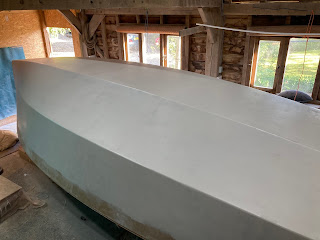Glassing the Hull
Glassing the Hull
This was a big day and a major milestone in our build! Having blended, rounded and faired the planking joints as much as we could we taped all of the joints using 2 layers of 600gsm triaxial tape, during this we sealed all the plywood with epoxy, just rolling it on with a paint roller so that when we laminated the bare plywood wouldn't pull resin out of the laminate and leave it dry. We covered the hull in peel ply and let this cure and then gave it a light sand up to remove any amine residue not caught by the peel ply and give it a key for the main lamination.
We completed the main lamination in a single day, having drafted in a couple of extra helpers. We went for 600gsm woven roving to give a total laminate weight of 1200gsm - slightly over the requirements.
We worked on a basis of a glass to resin ratio of 2:1 so for every m^2 of fibreglass we needed 1.2kg of resin. We had someone measuring and mixing small batches constantly as the three of use were laminating.
As we were laminating quite heavy cloth we primed the hull with resin first, using approximately a third of our 1.2kg/m^2 mix, we then pressed the fibreglass cloth in to this and worked it in to the resin with consolidation rollers before brushing and rolling on the remaining resin and then rolling and rolling and rolling to consolidate the resin in the fibreglass cloth. We were using 1.5m wide fibreglass roll which roughly made for 4 lengthwise strips per layer with a suitable overlap.
600gsm cloth is right on the top limit of what I'd hand laminate with again - it was a long, hot and tiring day but we got it done - finally covering with peel ply after about 12 hours of constant work. If we had to do it again... I think I would choose 400gsm cloth and do the lamination in two stages putting down peel ply in between so we have a ready surface for the next layers.






Comments
Post a Comment